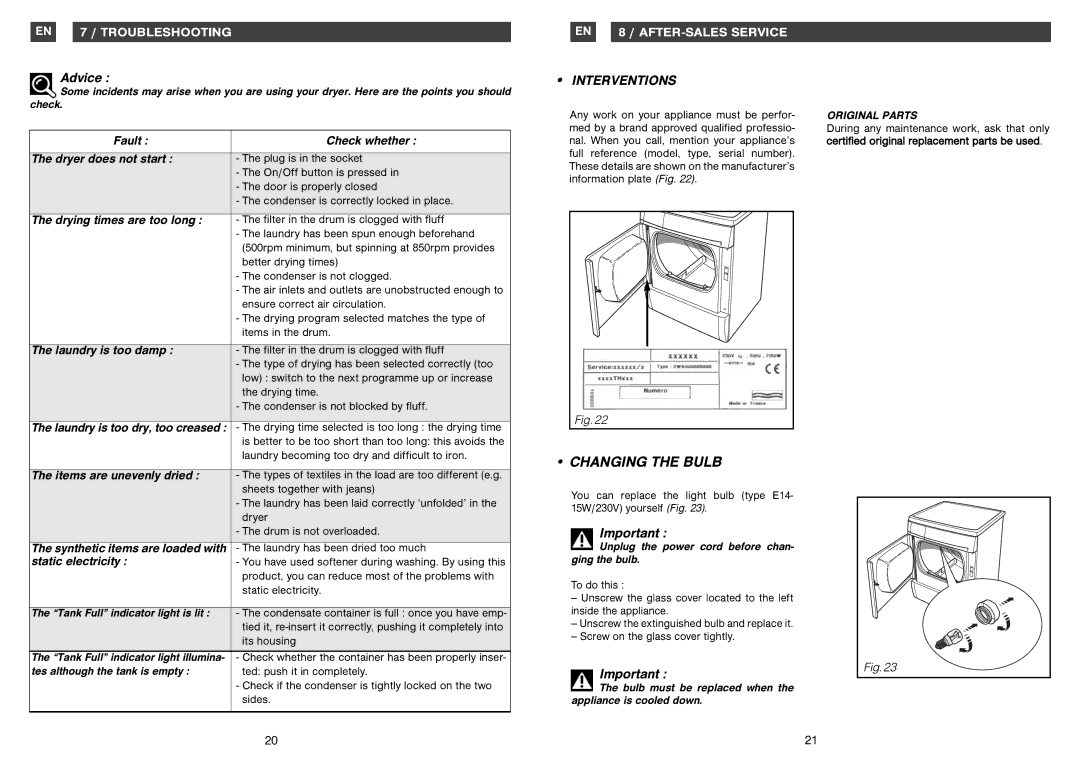
EN |
| 7 / TROUBLESHOOTING |
|
|
|
Advice :
Some incidents may arise when you are using your dryer. Here are the points you should check.
Fault : | Check whether : |
|
|
The dryer does not start : | - The plug is in the socket |
| - The On/Off button is pressed in |
| - The door is properly closed |
| - The condenser is correctly locked in place. |
EN | 8 / |
|
|
• INTERVENTIONS
Any work on your appliance must be perfor- med by a brand approved qualified professio- nal. When you call, mention your appliance’s full reference (model, type, serial number). These details are shown on the manufacturer’s information plate (Fig. 22).
ORIGINAL PARTS
During any maintenance work, ask that only certified original replacement parts be used.
The drying times are too long : | - The filter in the drum is clogged with fluff |
| - The laundry has been spun enough beforehand |
| (500rpm minimum, but spinning at 850rpm provides |
| better drying times) |
| - The condenser is not clogged. |
| - The air inlets and outlets are unobstructed enough to |
| ensure correct air circulation. |
| - The drying program selected matches the type of |
| items in the drum. |
|
|
The laundry is too damp : | - The filter in the drum is clogged with fluff |
| - The type of drying has been selected correctly (too |
| low) : switch to the next programme up or increase |
| the drying time. |
| - The condenser is not blocked by fluff. |
|
|
The laundry is too dry, too creased : | - The drying time selected is too long : the drying time |
| is better to be too short than too long: this avoids the |
| laundry becoming too dry and difficult to iron. |
|
|
The items are unevenly dried : | - The types of textiles in the load are too different (e.g. |
| sheets together with jeans) |
| - The laundry has been laid correctly ‘unfolded’ in the |
| dryer |
| - The drum is not overloaded. |
|
|
The synthetic items are loaded with | - The laundry has been dried too much |
static electricity : | - You have used softener during washing. By using this |
| product, you can reduce most of the problems with |
| static electricity. |
|
|
The “Tank Full” indicator light is lit : | - The condensate container is full : once you have emp- |
| tied it, |
| its housing |
The “Tank Full” indicator light illumina- | - Check whether the container has been properly inser- |
tes although the tank is empty : | ted: push it in completely. |
| - Check if the condenser is tightly locked on the two |
| sides. |
|
|
Fig. 22 |
• CHANGING THE BULB
You can replace the light bulb (type E14- 15W/230V) yourself (Fig. 23).
Important :
Unplug the power cord before chan- ging the bulb.
To do this :
—Unscrew the glass cover located to the left inside the appliance.
—Unscrew the extinguished bulb and replace it.
—Screw on the glass cover tightly.
Important :
The bulb must be replaced when the appliance is cooled down.
Fig. 23 |
20 | 21 |
